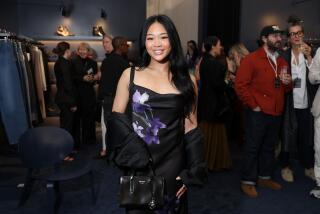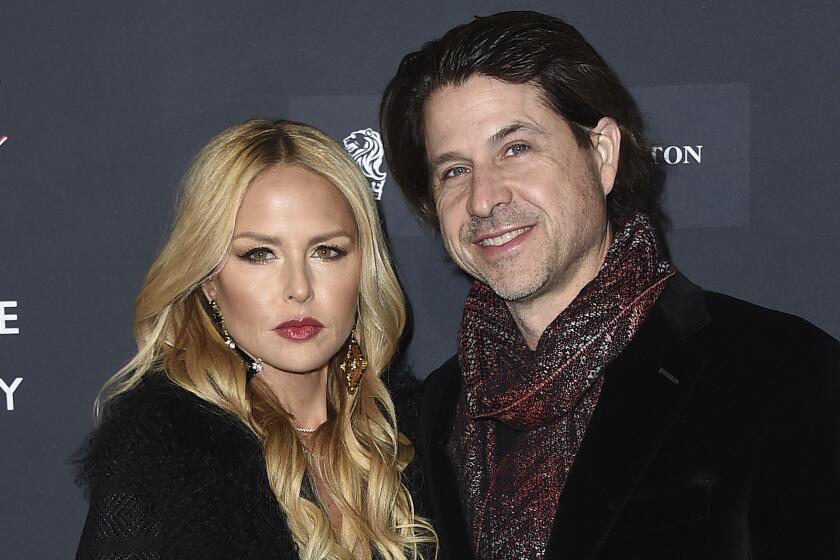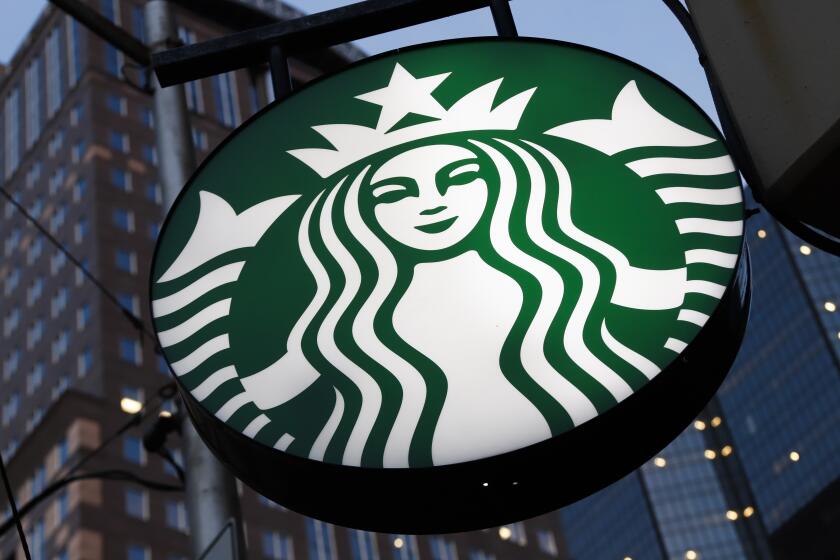New Sales Tactics in Store : O.C. Makers of Surf, Active Wear Opening Own Outlets in Efforts to Grow
James Jebbia’s trendy Union clothing store in New York’s SoHo district made its name in the ‘80s by selling fashions imported from England.
But in 1991, Jebbia added more apparel from the colonies after customers began clamoring for surf wear made by Stussy Inc. in Irvine. “I saw tons of potential for Stussy in New York, but Union just wasn’t big enough” to display it, Jebbia said.
At the same time, Shawn Stussy was trying to raise the visibility of his small company in the competitive New York market. He and Jebbia eventually opened a small SoHo shop called Stussy, and it caught New Yorkers’ attention by showcasing the company’s entire collection.
“This was a good way to go,” Jebbia said--good enough to prompt the opening of two more stores: The Stussy Union on La Brea Boulevard in Los Angeles and Stussy, a tiny storefront on North Coast Highway in Laguna Beach.
Stussy isn’t the only surf- and active-wear maker that has decided to sell directly to the public. Mossimo and Gotcha, both based in Irvine, and Quiksilver in Costa Mesa are also setting up shop. Others, including Club Sportswear in Irvine, are spending more money to ensure that their wares are properly displayed in retail stores.
What’s driving active-wear manufacturers into the risky world of retailing?
“Something called survival,” said Alan G. Millstein, editor of the trade journal Fashion Network Report in New York. “They have to grow in order to survive. And what alternatives do they have? They either sell to the discount marketers or sell on their own.”
Selling more clothes is the obvious goal, but manufacturers also view company stores as an effective way to let consumers know that they offer more than ball caps, T-shirts and swim trunks.
That message is increasingly important, industry observers say, because few department and specialty stores will give manufacturers the space for an entire line of clothing and accessories.
Mossimo, one of Southern California’s hottest apparel companies at the moment, has opened stylish department-store boutiques to showcase a collection that now includes caps, shirts, pants, sunglasses and swimwear. Founder Mossimo Giannulli now wants to open about 10 free-standing retail stores.
“We aren’t just about shirts anymore,” Giannulli said. “We do many wonderful things . . . and we want to isolate our customer with our look and feeling.”
Marketing wasn’t as important during the 1980s because the nation’s major department-store chains couldn’t stock enough goods from California’s beach-apparel makers.
“Kids who were mall rats, mall babies, became enamored of that (surfing) lifestyle,” Millstein said. “Even if they never got to an ocean, they fantasized a lot, and it became weekend wear in Indiana, Iowa or Idaho.”
That sales boom went bust in the early 1990s when beach fashions were eclipsed by darker, baggier urban designs. Many apparel buyers, deciding that the surfer look was dead, cut back dramatically on orders, said Shaheen Sadeghi, a former executive at both Quiksilver and Gotcha.
Before the boom ended, surf wear sales zoomed higher than $1 billion annually. But analysts now suggest that sales have fallen to about $750 million.
Adding insult to injury, the nation’s financially ailing department stores are doing a poor job of selling the California look, Sadeghi said. “It gets lost on the rack, and the surf companies can’t give a clear message to consumers on what they have to offer.
“Stussy, Quiksilver and the others all have their own personalities. . . . It’s just bad business to let a retailer select a few pieces out of your entire line and shove it in a rack with 15 other brands.”
That kind of retailing led apparel manufacturers to believe that “they need to display product better, and who knows how to display better than the manufacturers?” said Tony Cherbak, a retail industry consultant in the Costa Mesa office of accounting firm Deloitte & Touche.
The apparel makers aren’t all following the same game plan. While some are opening free-standing retail stores, others are setting up boutiques--small shops inside existing department and specialty stores. The rest are strengthening ties with the retailers who already market their wares.
Quiksilver is banking on a small chain of Boardriders Club stores to show off its growing product line. The company will open a 3,100-square-foot shop this summer in a strip mall in Santa Cruz and plans to add stores across the nation, particularly in areas where it doesn’t have a cadre of loyal customers.
Boardrider Clubs will feature not only surf wear, but also Quiksilver’s children’s line, snowboarding apparel, junior sportswear for girls, a growing assortment of accessories, a new line of “street” clothing and a menswear line aimed at older shoppers.
Quiksilver Chairman Robert B. McKnight Jr. said he doesn’t want to compete with the retailers who will continue to generate the bulk of Quiksilver’s revenue, so Boardrider Clubs will be restricted to locations where the company has little or no representation now.
Quiksilver hopes to use the Boardrider Clubs both to boost sales and to show retailers that there is a healthy market for the company’s merchandise--if it is marketed properly. “We’re trying to set an example to them of how to send the right message to consumers,” McKnight said.
Competitor Mossimo began sending its message to consumers last year with a handful of boutiques inside major department stores, including an eye-catching shop inside the Bullock’s men’s store at South Coast Plaza in Costa Mesa. Mossimo now is negotiating a lease for the company’s first free-standing store at a location not yet disclosed.
Boutiques and company stores are a staple among higher-end apparel makers. Talk to surf-wear company executives about their retail role models, and they respond with names like Armani, St. John Knits and Ralph Lauren, all of which have operated successful free-standing shops for years.
St. John, which opened the first of its 10 retail shops in 1989, also operates boutiques inside Saks, Neiman Marcus and Nordstrom department stores. Company-owned stores and boutiques accounted for about 10% of St. John’s $80.2 million in sales last year.
St. John, based in Irvine, likes the control that company stores and boutiques bring because it represents “the cleanest form of merchandising possible,” said Kelly Gray, St. John’s senior vice president and creative director.
“Clothing is displayed by itself, (which) helps the customer to better understand the collection,” Gray said. “And it also allows us to give better service because the sales associates have better training and product knowledge.”
High-ticket retailers aren’t the only manufacturers using company stores. Vans, the athletic footwear manufacturer based in Orange, sells to retailers but also has 75 of its own outlets.
Vans’ sales at company-owned stores grew by 20% to $25.7 million last year. And, its profit margin on shoes sold at those outlets was 66.5%, noticeably higher than the 46.8% margin on sales through other retailers.
For manufacturers who want to try retailing, now is as good a time as any, if only because a nationwide glut of commercial space translates into relatively cheap leases. And the shrinking number of major department-store chains, analysts say, has created a dearth of “name” retailers that can fill the empty storefronts.
Not all manufacturers, however, are cut out to be retailers. Gitano, a leading shoe manufacturer, “tripped and bloodied its nose with retail stores,” Millstein of Fashion Network Report said. Going it alone, he said, “has downside risks to it.”
Manufacturers also run the risk of stealing business from their own retail clients. That’s what happened last year when the Stussy Union opened within walking distance of American Rag, a store on La Brea Boulevard that does a brisk business in Stussy clothing. American Rag’s Stussy sales have been cut in half since the nearby store opened.
“If someone is already handling your product and handling it very successfully, it’s kind of a no-brainer . . . to open next door,” said American Rag owner Mark Werts.
“My only advice as a retailer is for guys to be very careful about entering a whole new ballgame,” Werts said of manufacturers. “Just because you’re a great tennis player doesn’t mean you’re going to be good at Ping-Pong.”
Millstein advises manufacturers to “hire savvy retailers to run the stores for them” because setting up shop “is not as easy as they fantasize it to be.”
Surf-wear executives say they’re aware of the risks.
Stussy and Jebbia, not the Stussy company, own the Stussy and Stussy Union stores. And, while Quiksilver is playing a major marketing and merchandising role with its Boardrider Clubs, individual retailers, not the company, will own the stores.
“We’re not retailers, we recognize that,” said Mark Price, Gotcha vice president. But in hard economic times, he said, manufacturers have to be concerned with how their wares are displayed.
Gotcha isn’t opening free-standing retail stores. Instead, it is experimenting with a “shop concept” inside surf shops. The idea, Price said, is to squeeze “incremental” sales out of retail locations that already do a good business.
Gotcha recently completed work on a boutique inside Newport Surf & Sport, a specialty store. While manufacturers typically provided signs and sales training, Gotcha went further: It installed new fixtures and flooring to set its area apart.
Tom Noble, president of Newport Surf & Sport, said retailers should welcome increased interest from manufacturers in how goods are marketed. “This is nothing different than what Ralph Lauren did in Macy’s with the Ralph Lauren store,” he said.
At the same time, retailers aren’t going to give their space away. In return for precious square footage, merchants will expect some benefits, Noble said. Manufacturers will have to ensure that shelves are stocked with the latest merchandise and that the retailer doesn’t have to absorb the entire cost if a given line doesn’t sell.
“There’s a realization by both the manufacturer and the retailer that they’ve both got to work closer together to be a success,” Cherbak of Deloitte & Touche said. “It’s definitely got to be a two-way street.”
Some in the surf-wear industry question whether manufacturers should venture into the retail end of the business at all.
Company stores “are obviously a growing trend,” said an Orange County surf-wear executive who asked not to be identified. But companies can’t automatically increase their sales, the executive said, just by opening their own stores:
“The public will determine if the demand is there.”
The Boutique Approach
A number of clothing makers, including these based in Orange County, are rethinking how their products are displayed and sold:
Quiksilver, which last year opened a small boutique in Hawaii, has plans this summer for a 3,100-square-foot, free-standing store in Santa Cruz. The company, based in Costa Mesa, plans additional stores in Chicago, New York, Miami, St. Louis, Kansas City, Portland, Ore., and Colorado. They will be owned by third-party retailers, but Quiksilver will handle a good portion of the marketing and merchandising.
Mossimo, which is negotiating a lease for its first free-standing store, founder Mossimo Giannulli says. The company, based in Irvine, hopes to have as many as 10 stores within five years, Giannulli said. It already has boutiques inside several department stores.
Gotcha, which completed work last week on a small “shop” inside Newport Surf & Sport. The company, based in Irvine, is considering additional boutiques at other surf shops.
Stussy Inc. Owner Shawn Stussy has opened three stores that sell the Irvine-based company’s clothing and apparel. Two of them, in New York and Los Angeles, are co-owned with retailer James Jebbia. A third store is in Laguna Beach.
Club Sportswear. The company, based in Irvine, says it is bolstering its in-store spending to help retailers market the Club line of apparel.
More to Read
Inside the business of entertainment
The Wide Shot brings you news, analysis and insights on everything from streaming wars to production — and what it all means for the future.
You may occasionally receive promotional content from the Los Angeles Times.










